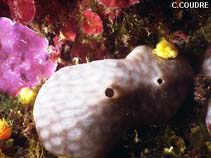Chondrosia reniformis Nardo, 1847
| Native range | All suitable habitat | Point map | Year 2050 |

|
| This map was computer-generated and has not yet been reviewed. |
| Chondrosia reniformis AquaMaps Data sources: GBIF OBIS |
Classification / Names Common names | Synonyms | CoL | ITIS | WoRMS
Demospongiae | Chondrillida | Chondrillidae
Environment: milieu / climate zone / depth range / distribution range Ecology
Sessile. Subtropical
Distribution Countries | FAO areas | Ecosystems | Occurrences | Introductions
Mediterranean.
Length at first maturity / Size / Weight / Age
Maturity: Lm ? range ? - ? cm
Short description Morphology
Species petrifying, likely to reach thickness a 4 cm, and able to cover almost completely with considerable surfaces. Smoothes of the surface with some rather large osculum. Rubbery consistency and toughness. Coloring varies according to the light intensity, of the white salts with brown dark marbled (Ref. 358).
Body thickness: 4 cm. Depth: As of surface until approximately 30 m of depth (Ref. 358). Biology: Species has neither spicules, nor fibers of spongin; it works out collagen fibers assuming of the functions of skeleton. Coloring of variable sponge according to the light intensity: the paler the intensity is weak, will be the colors. Conversely, subjected to an intense lighting, it will take darker colors. This phenomenon takes place at many animal species; pertaining to other zoological groups; and can be observed on a single individual: it is the case when the higher face; exposed to the light, is strongly colored, while the faces receiving little light remain definitely paler (Ref. 358).
Life cycle and mating behavior Maturity | Reproduction | Spawning | Eggs | Fecundity | Larvae
Members of the class Demospongiae are hermaphroditic. Life cycle: The zygote develops into parenchymella larva (free-swimming) before settling down on a substrate where it grows into a young sponge.
Main reference
References | Coordinator | Collaborators
Göthel, H. 1992. (Ref. 358)
IUCN Red List Status (Ref. 130435: Version 2024-1)
CITES status (Ref. 108899)
Not Evaluated
CMS (Ref. 116361)
Not Evaluated
Threat to humans
Human uses
| FishSource |
Tools
More information
Trophic Ecology
Food items
Diet
Food consumption
Ration
Predators
Diet
Food consumption
Ration
Predators
Ecology
Population dynamics
Life cycle
Distribution
Human Related
Aquaculture profile
Stamps, Coins Misc.
Stamps, Coins Misc.
Outreach
References
Internet sources
BHL | BOLD Systems | CISTI | DiscoverLife | FAO(Publication : search) | Fishipedia | GenBank (genome, nucleotide) | GloBI | Gomexsi | Google Books | Google Scholar | Google | PubMed | Tree of Life | Wikipedia (Go, Search) | Zoological Record
Estimates based on models
Preferred temperature
(Ref. 115969): 13.1 - 15.2, mean 13.9 (based on 56 cells).
Price category
(Ref. 80766):
Unknown.



